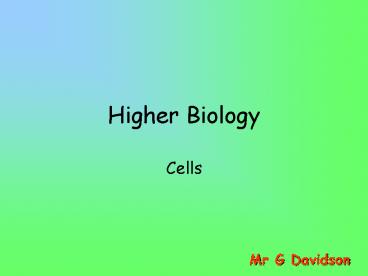Higher Biology - PowerPoint PPT Presentation
1 / 26
Title:
Higher Biology
Description:
... tissue often vary e.g. phloem tissue contains sieve tubes and companion ... Phloem tissue is composed of: sieve tubes which transport soluble carbohydrates ... – PowerPoint PPT presentation
Number of Views:390
Avg rating:3.0/5.0
Title: Higher Biology
1
Higher Biology
- Cells
Mr G Davidson
2
Unicellular Organisms
- Unicellular organisms consist of only one cell
and include animals and plants. - In order to survive, these organisms must be able
to carry out all the functions required for life,
e.g. gas exchange, feeding, reproduction ,etc. - Unicellular organisms include yeast, Amoeba,
Paramecium, Euglena, Pleurococcus, etc.
3
Unicellular Organisms
Pleurococcus
4
Unicellular Organisms
Amoeba
5
Unicellular Organisms
Paramecium
6
Unicellular Organisms
Euglena
7
Unicellular Organisms
- Amoeba have numerous pseudopodia which are blunt
projections, and the organism can flow into one
of these, moving like a leech. - The amoeba feeds by surrounding food particles
and engulfing them into food vacuoles where the
food is broken down by enzymes.
8
Unicellular Organisms
- Any undigested food remaining in the vacuole is
left behind until the vacuole can break through
the membrane and release it. - This process is called phagocytosis.
9
Phagocytosis
10
Tissues
- Multicellular organisms have many cells which are
organised into tissues to perform a particular
function. - Although tissues are adapted to carry out a
particular function, the cells of the tissue
often vary e.g. phloem tissue contains sieve
tubes and companion cells.
11
Tissues
- Epithelial tissues are lining tissues which cover
both internal and external surfaces of organisms.
12
Tissues
- A lining tissue often contains more than one type
of cell e.g. the trachea epithelium contains
ciliated and goblet cells. - The tissue is usually called after the
predominant cell type e.g. ciliated epithelia.
13
Tissues
- In ciliated epithelium the free surface has cilia
which beat rhythmically, enabling them to move
particles along tubes as in the trachea.
14
Ciliated Epithelium
15
Tissues
- Columnar epithelium is a tissue with column
shaped cells. - This type of tissue is found in the stomach and
small intestine linings. - The microvilli (s. microvillus) greatly increase
the surface area to allow for efficient
absorption of soluble molecules.
16
Columnar Epithelium
17
Tissues
- Glandular epithelium is made up of cells which
secrete substances e.g. enzymes, mucus and
hormones. - These cells are often clumped together to form
the glands of the body.
18
Glandular Epithelium
19
Plant Tissues
- Xylem tissue is composed of
- xylem vessels which offer strength
- tracheids whose cells overlap at the ends and
they transport water as well as provide support. - Xylem tissue has lignin impregnated walls which
provide support.
20
Plant Tissues
- Phloem tissue is composed of
- sieve tubes which transport soluble
carbohydrates - companion cells which control the sieve tubes.
21
Xylem Tissue
22
Phloem Tissue
23
Cell Ultrastructure
24
Cell Ultrastructure
- The ultrastructure of a cell is made up of cell
organelles which can be seen with the increased
power of the electron microscope.
Plant Cell
Animal Cell
25
Cell Ultrastructure
26
Cell Ultrastructure































